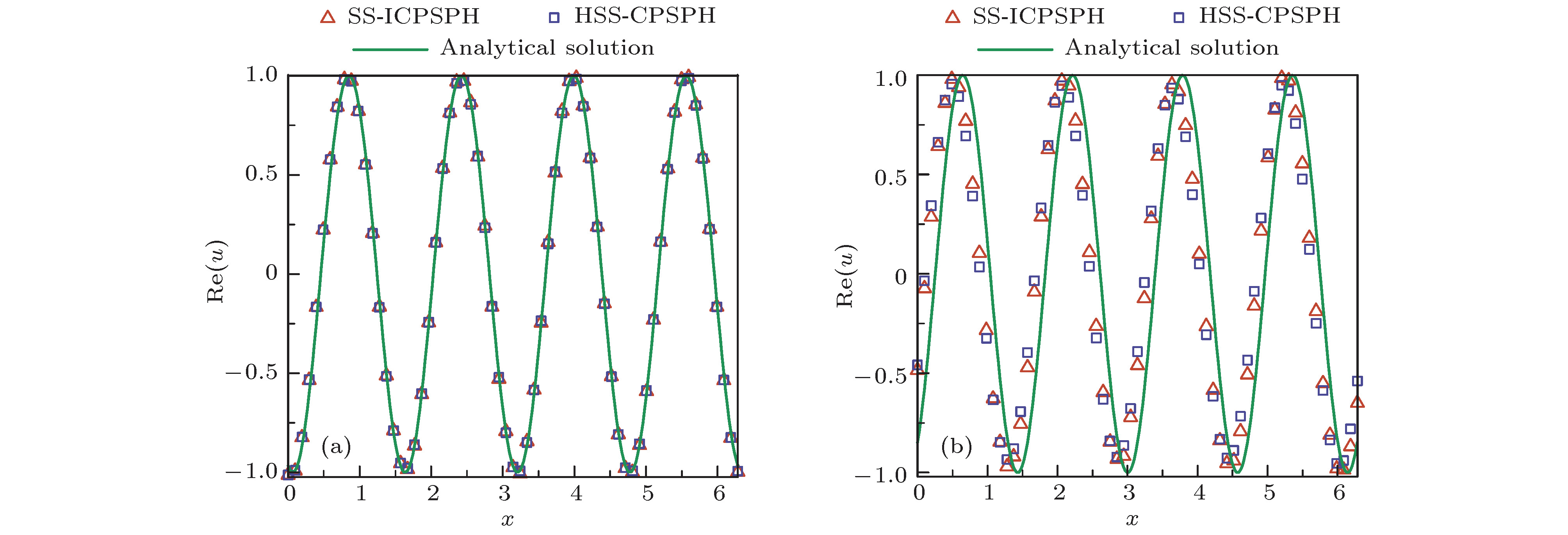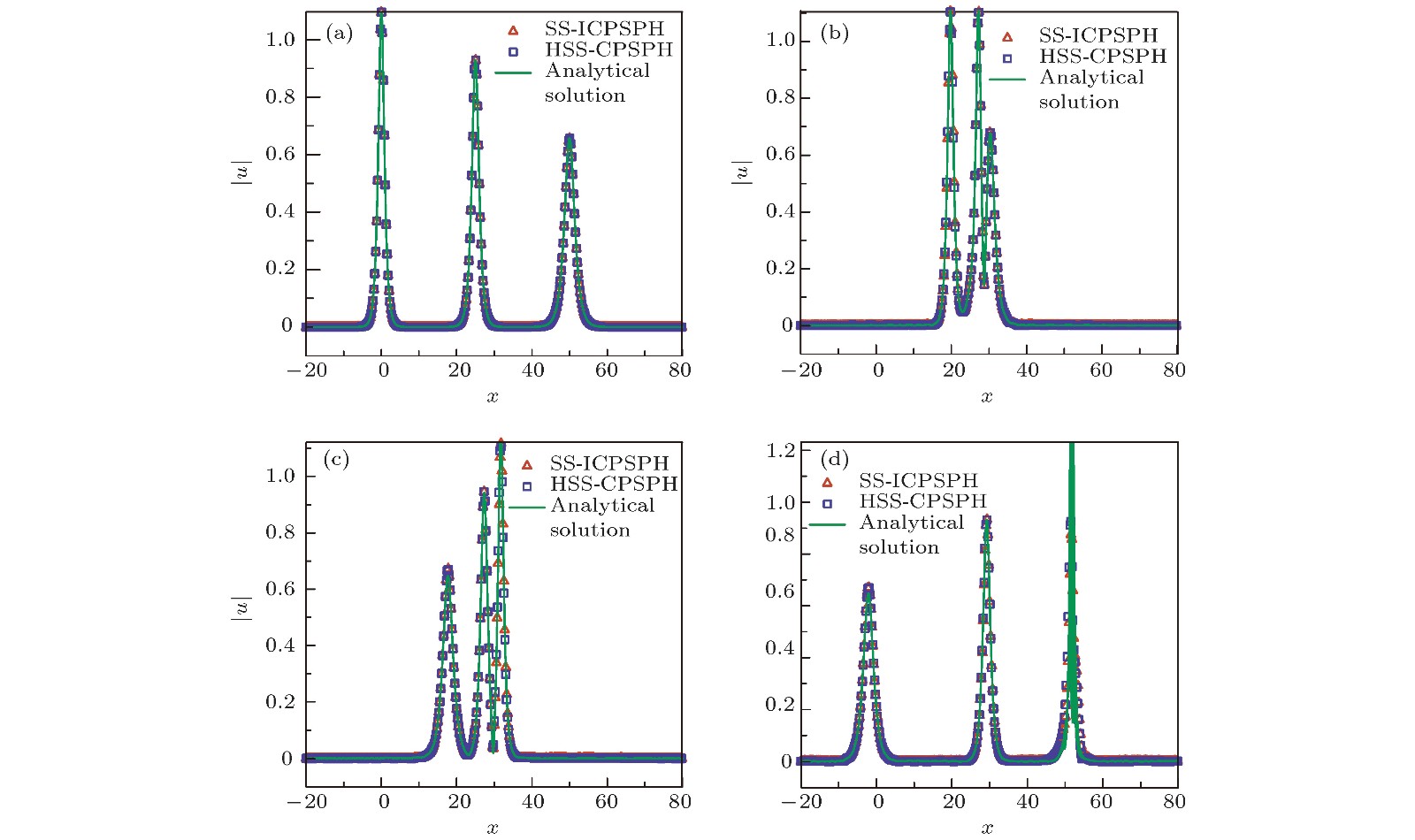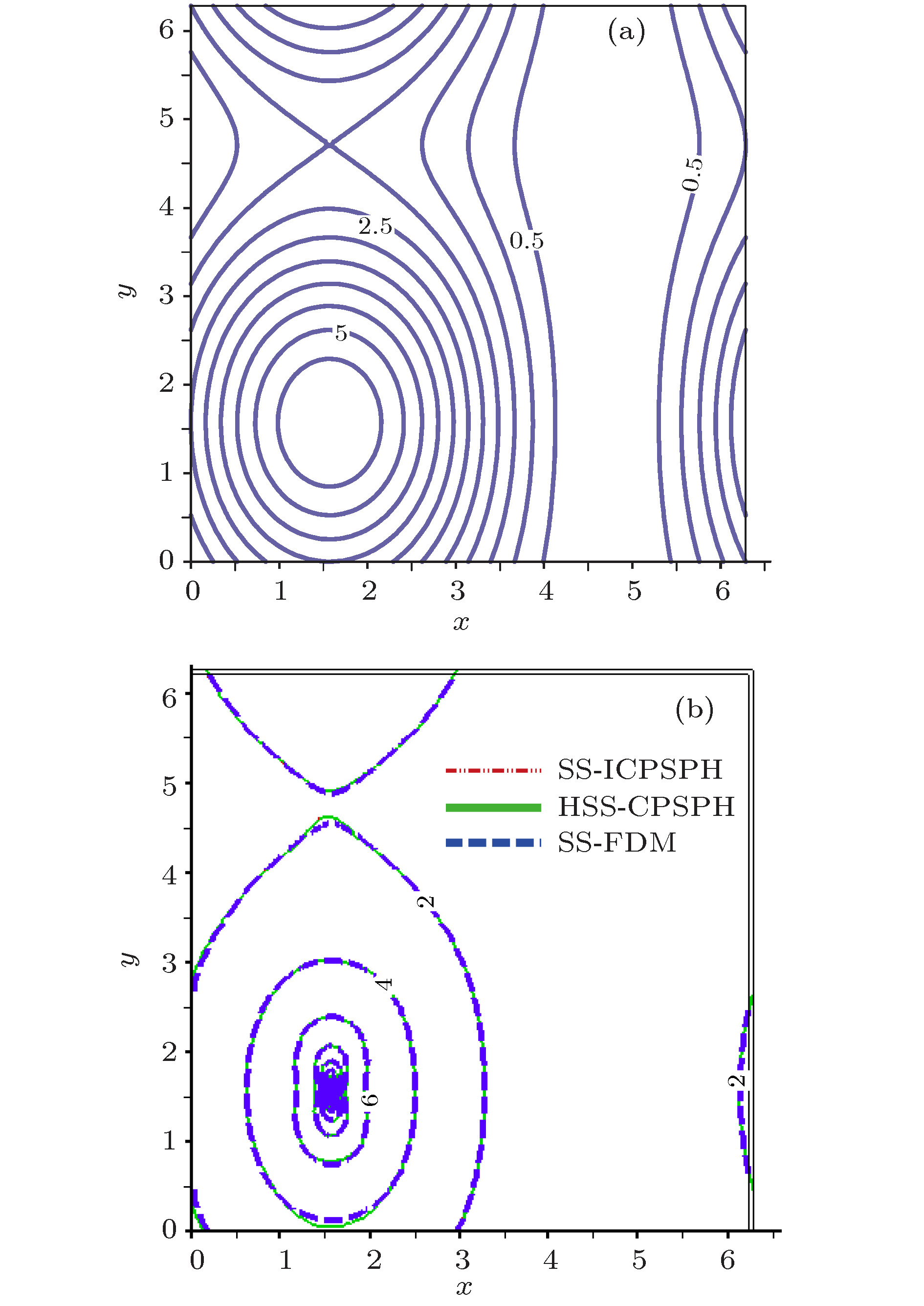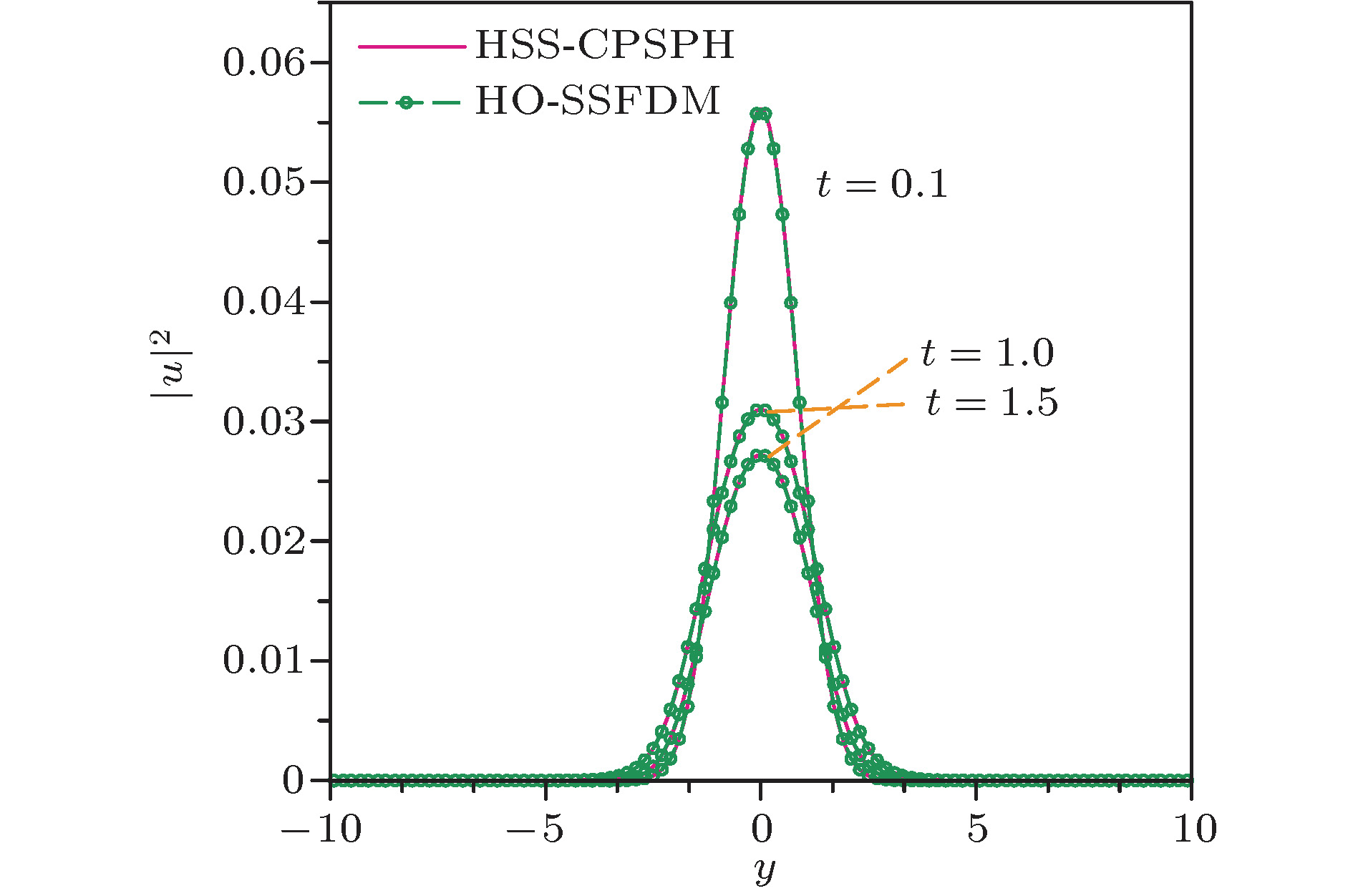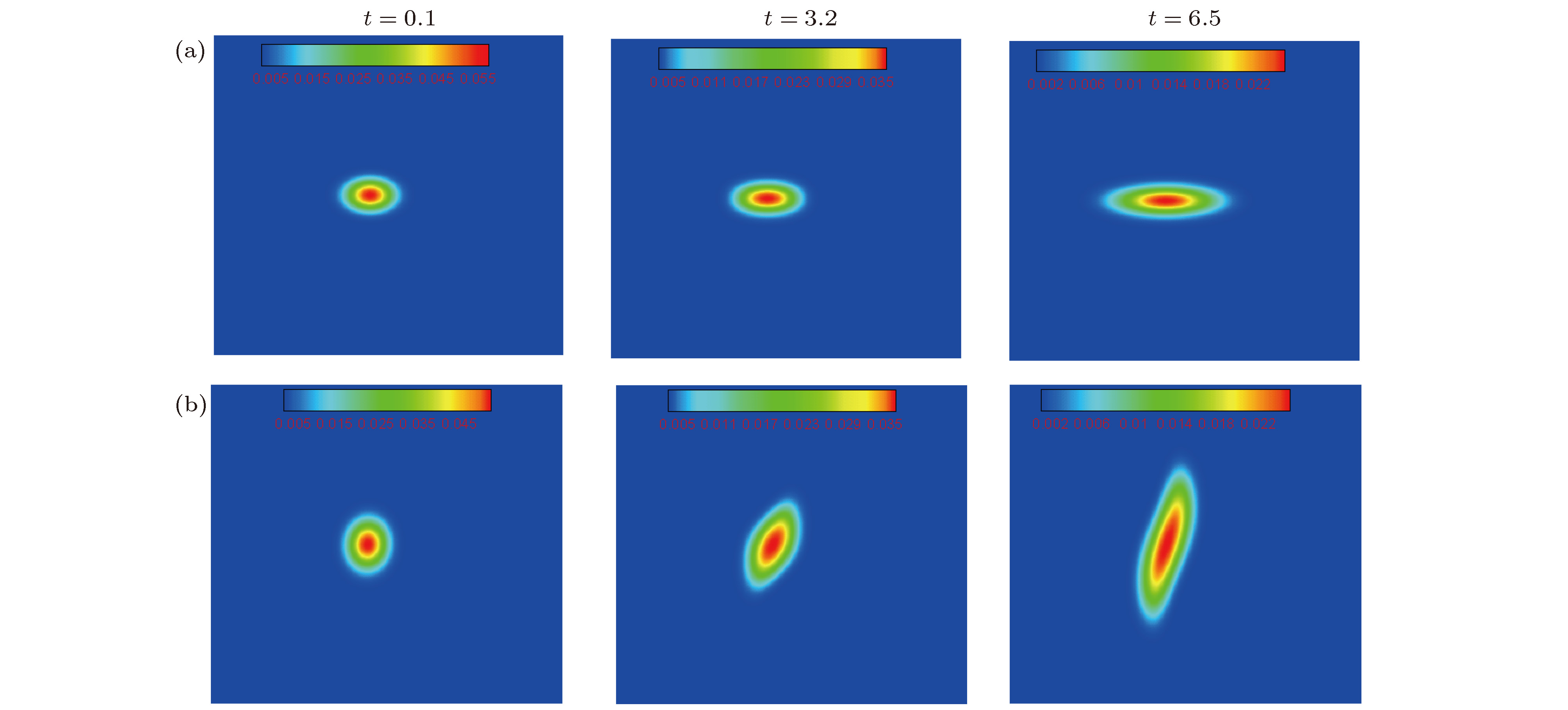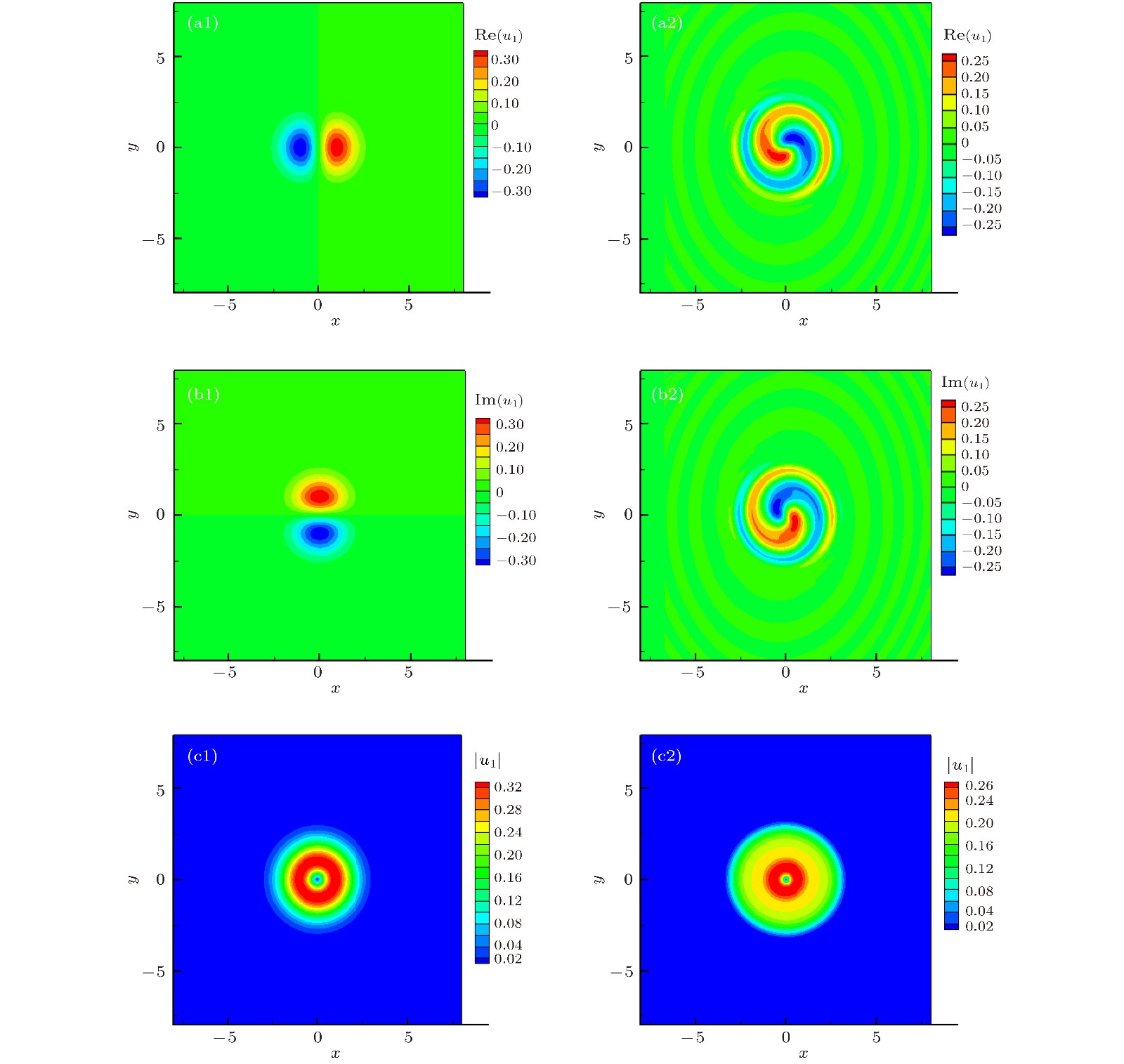-
To improve the numerical accuracy and computational efficiency of solving high-dimensional nonlinear Schrödinger/Gross-Pitaevskii (NLS/GP) equation by using traditional SPH method, a high-order split-step coupled with a corrected parallel SPH (HSS-CPSPH) method is developed by applying virtual particles to the boundary. The improvements are described as follows. Firstly, the nonlinear Schrödinger equation is divided into linear derivative term and nonlinear term based on the high-order split-step method. Then, the linear derivative term is solved by extending the first-order symmetric SPH method in explicit time integration. Meanwhile, the MPI parallel technique is introduced to enhance the computational efficiency. In this work, the accuracy, convergence and the computational efficiency of the proposed method are tested by solving the NLS equations with the periodic and Dirichlet boundary conditions, and compared with the analytical solutions. Also, the singularity of solitary waves under the periodic boundary condition is accurately obtained using the proposed particle method. Subsequently, the proposed HSS-CPSPH method is used to predict the results of complex two-dimensional and three-dimensioanl GP problems which are compared with other numerical results. The phenomenon of singular sharp angle in the propagation of nonlinear solitary wave and the process of quantum vortex under Bose-Einstein condensates with external rotation are presented accurately.
-
Keywords:
- nonlinear Schrödinger equation /
- smoothed particle hydrodynamics /
- time split-step /
- Bose-Einstein condensates
[1] Bandrauk A D, Shen H 1994 J. Phys. A: Gen. Phys. 27 7147
 Google Scholar
Google Scholar
[2] Yoshida H 1990 Phys. Lett. A 150 262
 Google Scholar
Google Scholar
[3] Wang T C, Guo B L, Xu Q B 2013 J. Comput. Phys. 243 382
 Google Scholar
Google Scholar
[4] Cheng R J, Cheng Y M 2016 Chin. Phys. B 25 020203
 Google Scholar
Google Scholar
[5] Wang D S, Xue Y S, Zhang Z F 2016 Rom. J. Phys. 61 827
[6] Bao W Z, Wang H Q 2006 J. Comput. Phys. 217 612
 Google Scholar
Google Scholar
[7] Bao W Z, Shen J 2005 SIAM J. Sci. Comput. 26 2010
 Google Scholar
Google Scholar
[8] Wang H Q 2005 Appl. Math. Comput. 170 17
 Google Scholar
Google Scholar
[9] Chen R Y, Nie L R, Chen C Y 2018 Chaos 28 053115
 Google Scholar
Google Scholar
[10] Chen RY, Nie L R, Chen C Y, Wang C J 2017 J. Stat. Mech. 2017 013201
 Google Scholar
Google Scholar
[11] Chen R Y, Pan W L, Zhang J Q, Nie L R 2016 Chaos 26 093113
 Google Scholar
Google Scholar
[12] Chen R Y, Tong L M, Nie L R , Wang C I, Pan W 2017 Physica A 468 532
 Google Scholar
Google Scholar
[13] Gao Y L, Mei L Q 2016 Appl. Numer. Math. 109 41
 Google Scholar
Google Scholar
[14] Xu Y, Shu C W 2005 J. Comput. Phys. 205 72−97
 Google Scholar
Google Scholar
[15] Jiang T, Chen Z C, Lu W G, Yuan J Y, Wang D S 2018 Comput. Phys. Commun. 231 19
 Google Scholar
Google Scholar
[16] Liu M B, Liu G R 2010 Arch. Comput. Meth. Eng. 17 25
 Google Scholar
Google Scholar
[17] 蒋涛, 陈振超, 任金莲, 李刚 2017 物理学报 66 130201
 Google Scholar
Google Scholar
Jiang T, Chen Z C, Ren J L, Li G 2017 Acta Phys. Sin. 66 130201
 Google Scholar
Google Scholar
[18] Chen J K, Beraun J E 2000 Comput. Meth. Appl. Mech. Eng. 190 225
 Google Scholar
Google Scholar
[19] Liu G R, Liu M B 2003 Smoothed Particle Hydrodynamics: A Mesh-free Particle Method (Singapore: World Scientific)
[20] Crespo A J C, Domínguez J M, Rogers B D, Gómez-Gesteira M, Longshaw S, Canelas R, Vacondio R, Barreiro A, García-Feal O 2015 Comput. Phys. Commun. 187 204
 Google Scholar
Google Scholar
[21] Ren J L, Jiang T, Lu W G, Li G 2016 Comput. Phys. Commun. 205 87
 Google Scholar
Google Scholar
[22] 刘谋斌, 常建忠 2010 物理学报 59 3654
 Google Scholar
Google Scholar
Liu M B, Chang J Z 2010 Acta Phys. Sin. 59 3654
 Google Scholar
Google Scholar
[23] Sun P N, Colagrosso A, Marrone S, Zhang A M 2016 Comput. Meth. Appl. Mech. Eng. 305 849
 Google Scholar
Google Scholar
[24] Huang C, Lei J M, Liu M B, Peng X Y 2015 Int. J. Numer. Methods Fluids 78 691
 Google Scholar
Google Scholar
[25] Huang C, Zhang D H, Shi Y X, Si Y L, Huang B 2018 Int. J. Numer. Meth. Eng. 113 179
 Google Scholar
Google Scholar
[26] Weideman J A C, Herbst B M 1986 SIAM J. Numer. Anal. 23 485
 Google Scholar
Google Scholar
-
图 1
${k_{\rm{1}}} = {k_{\rm{2}}} = 1,\;h = {\text{π}}/64$ 时不同时刻$u\left( {x,{\text{π}}} \right)$ 的实部沿x轴的变化 (a)$t=1$ ; (b)$t = 3$ Figure 1. Curve of the
$\operatorname{Re} \left( {u\left( {x,{\text{π}}} \right)} \right)$ along x-axis at different time with${k_{\rm{1}}} = {k_{\rm{2}}} = 1,\;h = {\text{π}}/64$ : (a)$t=1$ ; (b)$t = 3$ .图 2
${k_{\rm{1}}} = {k_{\rm{2}}} = 4,\;h = {\text{π}}/128$ 时不同时刻$u\left( {x,{\text{π}}} \right)$ 的实部沿x轴的变化 (a) t = 0.1; (b) t = 1Figure 2. Curve of the
$\operatorname{Re} \left( {u\left( {x,{\text{π}}} \right)} \right)$ along x-axis at different time with${k_{\rm{1}}} = {k_{\rm{2}}} = 4,\;h = {\text{π}}/128$ : (a) t = 0.1; (b) t = 1.图 9 两个不同时刻下t = 0 (第一列)和t = 0.25 (第二列)三个物理量等值线变化 (a1), (a2)
$ {\rm Re} ({u_1}) $ ; (b1), (b2)${\rm Im} ({u_1})$ ; (c1), (c2)$\left| {{u_1}} \right|$ Figure 9. Contours of three physical quantities at two different times t = 0 (the first row) and t = 0.25 (the second row): (a1), (a2)
$\operatorname{Re} ({u_1})$ ; (b1), (b2)$\operatorname{Im} ({u_1})$ ; (c1), (c2)$\left| {{u_1}} \right|$ .表 1
${k_{\rm{1}}} = {k_{\rm{2}}} = 1,h = {\text{π}}/64$ 时几个不同时刻里两种方法的误差${e_{\rm{m}}}$ Table 1. Error
${e_{\rm{m}}}$ obtained using two different methods at different time (${k_{\rm{1}}} = {k_{\rm{2}}} = 1,h = {\text{π}}/64$ ).时间t SS-ICPSPH HSS-CPSPH 0.5 1.697 × 10–3 1.696 × 10–3 1 3.616 × 10–3 2.494 × 10–3 2 7.347 × 10–3 4.857 × 10–3 表 2
${k_{\rm{1}}} = {k_{\rm{2}}} = 1$ , 时间t = 1时, 两种方法在不同粒子间距下的误差和收敛阶Table 2. Error
${e_{\rm{m}}}$ and convergent order$o{r_{\rm{\alpha }}}$ obtained using two different methods at$t=1$ and different particle distance (${k_1} = {k_2} = 1$ ).$h = {\text{π}}/32$ $h = {\text{π}}/64$ $h = {\text{π}}/128$ ${e_{\rm{m}}}$ $o{r_{\rm{\alpha }}}$ ${e_{\rm{m}}}$ $o{r_{\rm{\alpha }}}$ ${e_{\rm{m}}}$ $o{r_{\rm{\alpha }}}$ SS-ICPSPH 1.381 × 10–2 — 3.616 × 10–3 1.933 9.0412 × 10–4 2.00 HSS-CPSPH 1.381 × 10–2 — 2.494 × 10–3 2.47 4.498 × 10–4 2.47 表 3
${k_{\rm{1}}} = {k_{\rm{2}}} = 1,h = {\text{π}}/64$ 时, 粒子分布均匀或不均匀方式下, 两种方法的误差${e_{\rm{m}}}$ Table 3. Error
${e_{\rm{m}}}$ obtained using different methods at different distribution (${k_1} = {k_2} = 1$ ,$h = {\text{π}}/64$ ).均匀分布粒子 非均匀分布情形1 非均匀分布情形2 $t = 0.1$ $t = 1$ $t = 0.1$ $t = 1$ $t = 0.1$ $t = 1$ SS-ICPSPH 2.776 × 10–4 3.616 × 10–3 2.944 × 10–4 3.818 × 10–3 3.116 × 10–4 4.082 × 10–3 HSS-CPSPH 2.774 × 10–4 2.494 × 10–3 2.886 × 10–4 2.527 × 10–3 2.967 × 10–4 2.578 × 10–3 表 4
$h = {\text{π}}/64$ 时, 三个不同时刻两种方法的最大误差${e_{\rm{m}}}$ Table 4. Error
${e_{\rm{m}}}$ obtained using two different methods at three times ($h = {\text{π}}/64$ ).时间t SS-ICPSPH HSS-CPSPH 0.5 9.131 × 10–4 4.512 × 10–4 1 1.828 × 10–3 8.135 × 10–4 2 3.658 × 10–3 1.623 × 10–3 表 5 t = 1时不同空间步长情况下两种粒子方法的误差和收敛阶
Table 5. Error and order of convergence by different methods at t = 1 and different h.
$h = {\text{π}}/32$ $h = {\text{π}}/64$ $h = {\text{π}}/128$ ${e_{\rm{m}}}$ $o{r_{\rm{\alpha }}}$ ${e_{\rm{m}}}$ $o{r_{\rm{\alpha }}}$ ${e_{\rm{m}}}$ $o{r_{\rm{\alpha }}}$ SS-ICPSPH 7.553 × 10–3 — 1.828 × 10–3 2.046 4.316 × 10–4 2.082 HSS-CPSPH 4.534 × 10–3 — 8.135 × 10–4 2.476 1.379 × 10–4 2.560 表 6 粒子数为
${161^3}$ 时, 不同CPU个数下运行到不同步数所需时间(单位: s)Table 6. Consumed CPU time (unit: s) of different calculated time step with particle number
${161^3}$ at different CPUs.CPU数量 步数 相对加速比S num = 1 num = 10 num = 1000 2 97805.9 107508 1174728 — 12 16716.9 18516.7 215526.7 — 24 8388.87 9404.37 120284.37 1.792 36 5603.29 6344.98 87524.98 2.462 72 2948.83 3189.24 48564.28 4.438 表 7 在不同粒子数下不同CPU个数下, 运行到1000步时平均每步所消耗时间(单位: s)
Table 7. The average consumed CPU time (unit: s) of calculated time step 1000 with different particle number and different CPUs.
粒子数 CPU数量 2 12 24 36 72 ${121^3}$ 449.55 82.926 45.962 35.000 19.585 ${161^3}$ 1076.922 198.810 111.90 81.922 47.363 ${181^3}$ 1558.445 292.711 164.838 120.886 65.437 ${201^3}$ 2190.921 425.688 235.775 179.856 96.836 -
[1] Bandrauk A D, Shen H 1994 J. Phys. A: Gen. Phys. 27 7147
 Google Scholar
Google Scholar
[2] Yoshida H 1990 Phys. Lett. A 150 262
 Google Scholar
Google Scholar
[3] Wang T C, Guo B L, Xu Q B 2013 J. Comput. Phys. 243 382
 Google Scholar
Google Scholar
[4] Cheng R J, Cheng Y M 2016 Chin. Phys. B 25 020203
 Google Scholar
Google Scholar
[5] Wang D S, Xue Y S, Zhang Z F 2016 Rom. J. Phys. 61 827
[6] Bao W Z, Wang H Q 2006 J. Comput. Phys. 217 612
 Google Scholar
Google Scholar
[7] Bao W Z, Shen J 2005 SIAM J. Sci. Comput. 26 2010
 Google Scholar
Google Scholar
[8] Wang H Q 2005 Appl. Math. Comput. 170 17
 Google Scholar
Google Scholar
[9] Chen R Y, Nie L R, Chen C Y 2018 Chaos 28 053115
 Google Scholar
Google Scholar
[10] Chen RY, Nie L R, Chen C Y, Wang C J 2017 J. Stat. Mech. 2017 013201
 Google Scholar
Google Scholar
[11] Chen R Y, Pan W L, Zhang J Q, Nie L R 2016 Chaos 26 093113
 Google Scholar
Google Scholar
[12] Chen R Y, Tong L M, Nie L R , Wang C I, Pan W 2017 Physica A 468 532
 Google Scholar
Google Scholar
[13] Gao Y L, Mei L Q 2016 Appl. Numer. Math. 109 41
 Google Scholar
Google Scholar
[14] Xu Y, Shu C W 2005 J. Comput. Phys. 205 72−97
 Google Scholar
Google Scholar
[15] Jiang T, Chen Z C, Lu W G, Yuan J Y, Wang D S 2018 Comput. Phys. Commun. 231 19
 Google Scholar
Google Scholar
[16] Liu M B, Liu G R 2010 Arch. Comput. Meth. Eng. 17 25
 Google Scholar
Google Scholar
[17] 蒋涛, 陈振超, 任金莲, 李刚 2017 物理学报 66 130201
 Google Scholar
Google Scholar
Jiang T, Chen Z C, Ren J L, Li G 2017 Acta Phys. Sin. 66 130201
 Google Scholar
Google Scholar
[18] Chen J K, Beraun J E 2000 Comput. Meth. Appl. Mech. Eng. 190 225
 Google Scholar
Google Scholar
[19] Liu G R, Liu M B 2003 Smoothed Particle Hydrodynamics: A Mesh-free Particle Method (Singapore: World Scientific)
[20] Crespo A J C, Domínguez J M, Rogers B D, Gómez-Gesteira M, Longshaw S, Canelas R, Vacondio R, Barreiro A, García-Feal O 2015 Comput. Phys. Commun. 187 204
 Google Scholar
Google Scholar
[21] Ren J L, Jiang T, Lu W G, Li G 2016 Comput. Phys. Commun. 205 87
 Google Scholar
Google Scholar
[22] 刘谋斌, 常建忠 2010 物理学报 59 3654
 Google Scholar
Google Scholar
Liu M B, Chang J Z 2010 Acta Phys. Sin. 59 3654
 Google Scholar
Google Scholar
[23] Sun P N, Colagrosso A, Marrone S, Zhang A M 2016 Comput. Meth. Appl. Mech. Eng. 305 849
 Google Scholar
Google Scholar
[24] Huang C, Lei J M, Liu M B, Peng X Y 2015 Int. J. Numer. Methods Fluids 78 691
 Google Scholar
Google Scholar
[25] Huang C, Zhang D H, Shi Y X, Si Y L, Huang B 2018 Int. J. Numer. Meth. Eng. 113 179
 Google Scholar
Google Scholar
[26] Weideman J A C, Herbst B M 1986 SIAM J. Numer. Anal. 23 485
 Google Scholar
Google Scholar
Catalog
Metrics
- Abstract views: 15663
- PDF Downloads: 150
- Cited By: 0























 DownLoad:
DownLoad:
